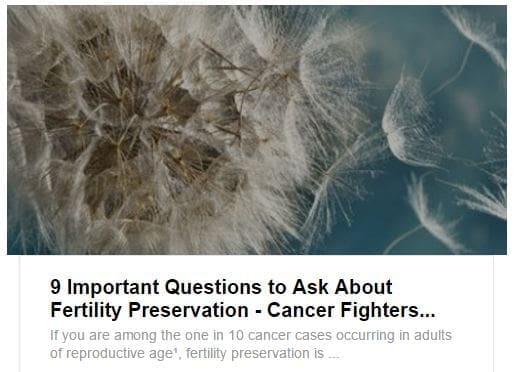Options for Fertility Preservation after Ovarian Cancer Diagnosis
Ovarian cancer is the fifth leading cause of cancer death in women. Typically affecting older women—the average age is 63—another subset of the female population can develop the condition at a much younger age. Researchers say that 1 in 10 women will develop a cancer during their childbearing years and for those who develop ovarian cancer, special consideration must be given to protecting a woman’s eggs or reproductive tissue. This is referred to as fertility preservation. Cancer treatments like chemotherapy or radiation can dramatically effect or eliminate a woman’s ability to have biological children later. Preservation is a decision that cannot be made lightly and it’s important that patients work closely with their doctor and support system to determine what risk their cancer treatment will have on their future fertility so they may make an informed decision.
Many patients fail to discuss preservation because they are processing the shock of a cancer diagnosis, afraid to broach the subject, or they are simply unaware that there are options available. Each cancer case is unique to each patient and today’s treatments can be more tailored than ever thanks to tools like liquid biopsy cancer screening tests and advanced pathology approaches that give more details and insights about the type of cancer a patient has and what approaches for treatment may be most effective. Because of each individual’s unique case, no two people will have the same risk to their fertility.
However, here are a few of the most common preservation options to consider:
Embryo banking—Eggs are harvested from the ovaries and fertilized with sperm through in vitro fertilization (IVF). The embryos are then frozen for implantation into the uterus at a later date. Donor sperm or a male partner is necessary to complete this process.
Egg banking—The collection and freezing of unfertilized eggs for future use. Single women or those who are opposed to freezing embryos may prefer this procedure.
Radiation shielding—The ovaries are shielded to reduce scatter radiation. This process does not protect the ovaries from the effects of chemotherapy.
Ovarian transposition—Relocation of the ovaries out of the treatment area. This is usually done during other reproductive surgery, before cancer treatment begins, but would not protect the ovaries from chemotherapy.
Once cancer treatment begins, it may not be too late to discuss fertility preservation so don’t be afraid to bring it up if you haven’t already. In addition, here are a few questions you may want to ask your doctor:
· Will any of my fertility preservation options delay cancer treatment? What are the risks if we have to wait?
· Will any of these options affect my health or the health of my future children?
· Are there any clinical trials available for me?
· Will fertility treatments or a future pregnancy raise the risk for a cancer recurrence?
· Where can I find support while I make this decision?
· Where can I get more information about fertility preservation?
Once you’ve spoken with your doctor, it’s time to make a decision. Use the information they give you about your specific case, the input of your spouse, partner or family and your own values to make the decision that’s right for you.
References:





3 Comments
KATE SARSFIELD
It must be a desperate situation to be in. Cancer sucks 🙁
Sarah L
Interesting article. Good info for women who might need it.
michele
This is one of the most important posts that you have done.. The info in the post is something that all women should be aware of.. i am passing this on to daughters of my friends.. Thank you Connie